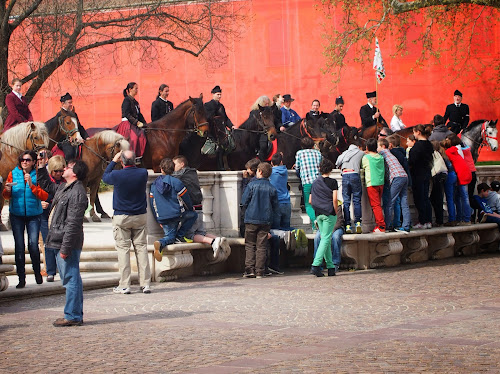Godolo (pretend there are umlauts over all those “o”s) Palace was a wedding gift to Emperor Franz Josef and Queen Elisabeth, they of the dual monarchy of Austria and Hungary. Elisabeth loved to spend time there and was fluent in Hungarian. Having fallen on hard times, such as WWI, WWII and Soviet occupation, a restoration program has begun to make a real difference and the interior has significant sections open to the public. People of the village managed to hide a substantial number of the furnishings during WWII and brought them out after the Soviets left, meaning that there are original furnishings from the Hapsburgs in Godolo palace (a no photography zone). Violet, Elisabeth’s favorite color, is much in evidence, although she only wore black after her son Rudolf died under suspicious circumstances and was herself assassinated by a publicity seeker in Switzerland. Franz Josef must have wondered about Elisabeth. Her favorite Hungarian poet was a revolutionary dedicated to ouster of the Hapsburg dynasty. During our visit, the Hungarians were commemorating a battle against the Austrians in the 19th century. They lost.
Once again, we find that we must backtrack a bit to correct the record. Returning to the Synagogue, we discovered from our guide Reuben (from, among other places, Queens) that the Synagogue is actually the world’s second largest synagogue (#1 being in NYC). It seats 3500 without extra chairs brought in. It’s a Neologue synagogue, which is the same as (or akin to) Conservative Judaism. The reason it looks so much like a church is that it was designed by a Catholic architect and the city at the time (the 19th century) restricted architectural styles. Reuben let loose his sense of humor to try to explain the difference between Neologue and Orthodox (as a non-observant Jew). [This rabbi walks into a butcher shop and points to the shank of ham behind the counter. I’ll take that nice piece of smoked salmon. But rabbi, that’s a piece of ham. You call it what you like, I’ll take that beautiful gefilte fish.] On a more sober note, we found the memorial tree to Hungarian Jews killed in the Holocaust to be quite evocative. There are 5,000 names engraved on individual metal leaves on The Tree of Life, the willow tree traditionally representing mourning.







